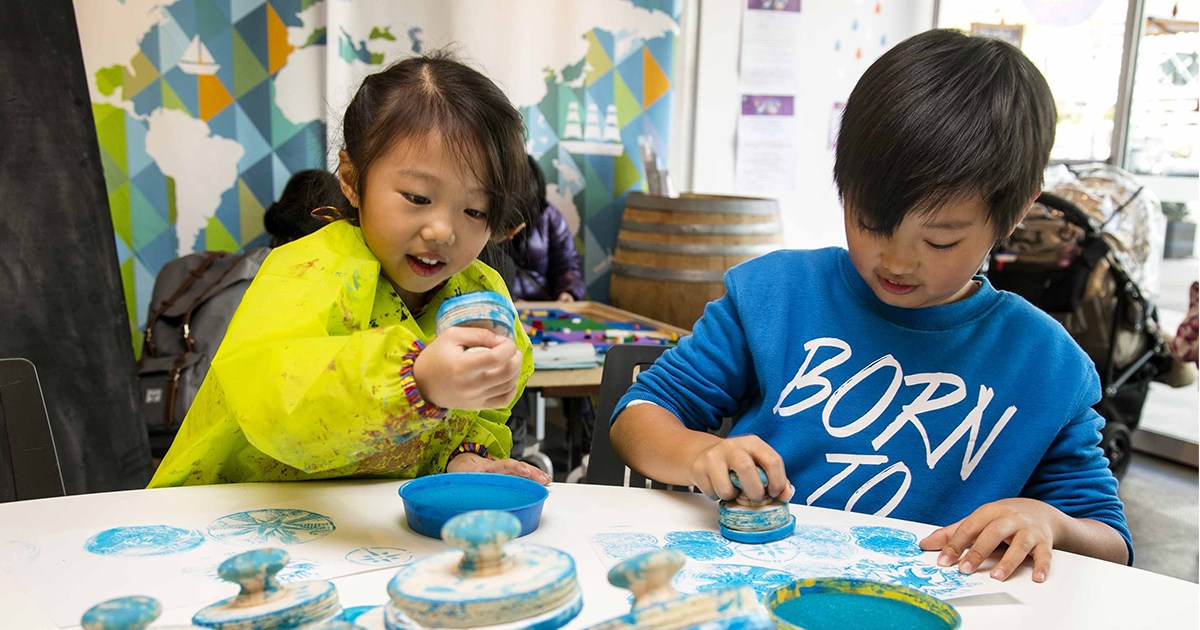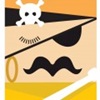

Printmaking fun with the Kids on Deck programs for Ships, Clocks and Stars, 2016. Image: Annalice Creighton/ANMM.
Kids on Deck, our regular Sunday and School Holiday family program for primary school aged children and their carers, celebrates its 20th birthday this year.
Over the last 20 years, close to 500,000 visitors have participated in Kids on Deck activities, creating well over one million handcrafted souvenirs of their visit to the museum in paper, clay, string, glitter, plaster, beads, fabric, paint, sewn badges, worn temporary tattoos and much, much more… They have dressed up in costumes, enacted all manner of theatre of imaginary play, climbed on replica vessels, mastered the art of puppetry and lounged in inflated igloos. They have engaged in creative play and discovery learning, inspired by hundreds of different exhibitions on history, science, art, design and popular culture.
Families welcomed
Perhaps more important than this, is that 20 years of this seemingly small corner of museum activities also marks a larger commitment to making this place a space of fun, creative and memorable learning experiences for families. A maritime museum could quite easily veer towards showcasing Eurocentric histories and attracting older, mostly male, boat and heritage enthusiast audiences (it’s a common perception people have of the genre even today). However, the museum decided early on to invest in consistent low fee, accessible programming for younger audiences and the first Kids on Deck was held in 1998. Since then, a whole suite of family-friendly activities have sprung up – including all of our current favourites: Mini Mariners, Creative Workshops, Family Fun Days, Stroller Tours, Cabinet of Curiosities and performances.
The leadership of Commercial and Visitor Services, as it was known then, ‘had a vision’ says Di Osmond, former Visitor Programs Manager (1997-2003). They wanted to ‘to increase public visitation and increase membership and (we) felt very strongly that family programs were the way to do it….’ What started as ‘a space with creative activities related to maritime subjects, current exhibitions and special events… communicating the message to children that museums are for everyone’ (ANMM Annual Report 1997-1998) rapidly grew a reputation for playful museum experiences that would be a mainstay of the museum’s public programs to the present day.
 PLAY, 2001. Image: ANMM. '>
PLAY, 2001. Image: ANMM. '>Inside the museum’s early interactive family exhibitions, PLAY, 2001. Image: ANMM.
Like a travelling circus, Kids on Deck moved from place to place. It has appeared in the back corners of the Navy gallery, a demountable classroom, sprawled inside temporary exhibitions, hopped onboard visiting vessels and even found a place on our very own HMAS Vampire. It’s travelled offsite too: down the coast to local festivals, along the corridors of children’s hospitals, the sweaty marquees and florescent-lit expanses of trade shows, weighed anchor amongst the commanding turbine halls of Cockatoo Island.
Alongside early programs grew theatrical shows, a wacky cast of maritime characters, storytime or stories, circus and pantomime. Theatrical tours were developed by the museum’s more dramatically inclined educators and visitor programs staff, and first forays into immersive interactive family exhibitions that stretch from 1998’s Pirates (exhibited again in 2006-2007 and 2012-2013) to Secrets of the Sea (1999-2002), Oceans of Stories and PLAY (2001) which lead to our long-lived summer outdoor science and water play attraction Wetworld. More recently, the pursuit of family-friendly museum experiences has manifested in brilliant interactive touring shows such as Voyage to the Deep and Horrible Histories Pirates: The exhibition.
Growing the visitors of tomorrow
Making whole museums, exhibitions and public programs for families is not new, it’s been happening all over the world since the late 19th century, but it remains a strategic investment in the long-term vitality of the institution and its stories. Museums have a unique place in the cultural landscape to be spaces for intergenerational social experiences, live conversations, curiosity, creativity, meaning-making and memorable learning experiences, that are inspired by but not limited to their collections. Families make up over half of all visitors to the museum and as every cultural organisation knows, positive experiences of museums in childhood are a huge factor in determining whether someone will visit again (and again) throughout their lifetime.
Many of the children who visited Kids on Deck in its early years, are now the faces of the family programs casual staff. Something as humble as a handmade sculpture that they put together and kept with pride of place upon their bookcase, bore the ultimate objective of any kinaesthetic learning activity: they fondly remembered the museum, were happy to return, and eventually, to invest their own time and talents into this program.
‘I remember making an air drying clay sculpture, covered in all different sea creatures in Kids Deck [during the Secrets of the Sea exhibition], I hung it up on my wall at home for years, I think I still have it somewhere…’ says Megan Baehnisch, a current supervisor in family programs.
‘We have seen kids starting a session at the start of the day, and leaving with an impressive masterpiece five hours later. I’ve seen shipwrights and marine architects in the making, and had wonderful conversations with budding historians and geographers’ recalls Tiffany Hastings, another member of Kids on Deck staff. ‘What is even more precious to me, is being able to work with the amazing team, who are ever so passionate about encouraging each child who walks through that door has the chance to realise their creative potential.’
Theatre and play
For educator, and character guide extraordinaire, John Lamzies, the summertime family exhibition and activities program called Pirates! that museum ran in 1998 was the catalyst for decades of him delivering magical theatrical public programs. John volunteered to dress as a pirate to help muster children along to the gallery and he was an instant success. ‘They responded beautifully to his deliciously scary incarnation, Captain Grognose Johnny, and it was an obvious move to incorporate this extra dimension of his skill set into other school and holiday programs,’ recalls Jeffrey Fletcher, Senior Education Officer. John was one of many extraordinary actors amongst the early education and public programs staff who took the museums theatrical tours to new heights of fanciful filibustering fun, employing theatre as a powerful interpretation device for all manner of complex and serious exhibitions to connect our young audiences with the content through immersive, emotive and memorable storytelling.

Actor Paul Wilson dressed as Bosun Mess, our first Kids on Deck mascot, on board HMAS Vampire. Image: ANMM.
Among John’s personae are the enticingly cheeky pirate Grog-nose Johnny, Stormy Grey, the 185-year-old stowaway; reggae-loving jellyfish expert, Dr. Shaka Wobbly, French able seaman Maurice Matelot, accompanied by Renée, his imaginary rabbit and Ice man Otzi, just to name a few. John can still be seen on many a torchlight tours or family fun day events, always mustering a motley crew of children and carers outside Kids on Deck, who are ready to be swept along on a tour that will be equal parts eccentric, hilarious, educational and immensely entertaining.

Character guide chameleon John Lamzies as Otzi the Iceman, 2007. Image: ANMM.
Actor and clown-doctor Paul Wilson is yet another who has a long history of theatrical aliases at the museum. He recalls the controversial cardboard cut-out that was Kids on Decks first mascot: Bosun Mess. Bosun Mess was devised as a roving character as well as a brand for the then new initiative of Kids on Deck. ‘He was a little cheeky, always silly and great fun.’ But it wasn’t long until there were ‘complaints about his carrying a sword’.
Thanks for the memories
Behind the scenes we’ve kept sailing in most part due to many gifted staff who’ve passed through (and in some cases stayed for the long haul) in our programs and education team, some wonderful communications staff, visitors services teams, our incredible designers and preparators (who make the most spectacular custom paper-craft and never fail to turn a challenging near zero dollar budget into a beautifully crafted mechanical interactive in under three days).
Like any public program, it’s a quiet success. Kids on Deck was never a blockbuster exhibition, a major building project, a hero object or stakeholder event, it was unlikely to ever grace a building banner, be featured on a bus back advertisement or Signals front cover. But it is the one, the many, the thousands, of tangible memories of small moments at the museum whereby perhaps something was seen, (for the first time or again and again), that was delightful, surprising, furiously coloured, diligently decorated, embodied in a masterpiece of cardboard engineering, lengths of string and sticky tape, a smidge of uhu, a sprinkle of glitter and a few bobbing wiggly eyes.
— Annalice Creighton, Public Programs Coordinator.
You can find more great craft ideas on our kids make and do page and further information on kids programs here.

















